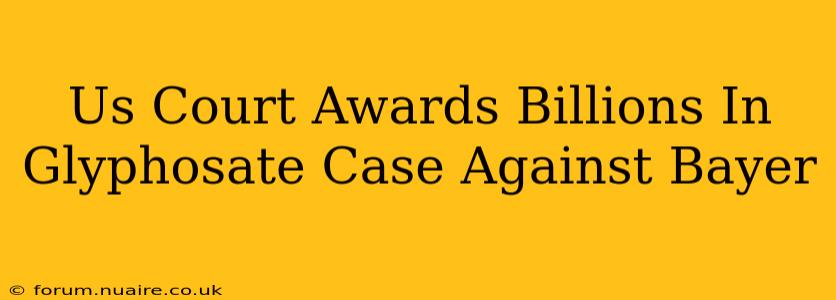US Court Awards Billions in Glyphosate Case Against Bayer: A Landmark Ruling and its Implications
A California jury has awarded a staggering $2 billion in damages to plaintiffs claiming Roundup, Bayer's glyphosate-based herbicide, caused their cancer. This landmark verdict, though likely to be reduced on appeal, marks a significant escalation in the legal battle surrounding glyphosate and its potential link to non-Hodgkin lymphoma (NHL). The decision sends shockwaves through the agricultural industry and raises crucial questions about corporate responsibility and the safety of widely used pesticides.
Understanding the Glyphosate Controversy
Glyphosate, the active ingredient in Roundup, is the world's most widely used herbicide. For decades, it has been lauded for its effectiveness in controlling weeds in agriculture and residential settings. However, a growing body of research and numerous lawsuits allege a link between glyphosate exposure and the development of NHL.
Key Arguments Presented in the Case:
- Plaintiffs argued: Prolonged exposure to glyphosate, through both occupational and residential use of Roundup, directly caused their NHL. They presented evidence from epidemiological studies, toxicology reports, and expert testimony to support their claims.
- Bayer (Monsanto's successor) countered: The company maintained that glyphosate is safe when used as directed and that there is insufficient scientific evidence to establish a causal link between glyphosate exposure and NHL. They highlighted studies that found no such connection and criticized the methodology used in studies that did.
The $2 Billion Verdict: A Significant Blow to Bayer
The jury's decision to award $2 billion – $1 billion in compensatory damages and $1 billion in punitive damages – represents a resounding victory for the plaintiffs and a major setback for Bayer. While the punitive damages are likely to be significantly reduced by the court, the sheer magnitude of the award underscores the jury's belief in the plaintiffs' claims.
Potential Impact of the Ruling:
- Future Litigation: This verdict could embolden thousands of other plaintiffs currently suing Bayer over similar claims. The outcome could set a precedent for future settlements and potentially lead to billions more in payouts for the company.
- Regulatory Scrutiny: The ruling is likely to intensify regulatory scrutiny of glyphosate and could lead to stricter regulations or even a ban on the herbicide in certain jurisdictions. Agencies like the EPA in the US will be under increased pressure to re-evaluate the safety of glyphosate.
- Bayer's Financial Position: The multi-billion dollar liability presents a significant financial challenge for Bayer, potentially impacting its stock price and future investments.
- Consumer Confidence: The verdict will likely impact consumer confidence in glyphosate-based herbicides, potentially driving demand for alternative weed control methods.
The Road Ahead: Appeals and Ongoing Litigation
Bayer has already indicated its intention to appeal the verdict. The appeals process could take years, and the final outcome remains uncertain. Meanwhile, thousands of similar lawsuits remain pending, and the legal battle surrounding glyphosate is far from over.
Where to Find More Information:
- Official Court Documents: Access court filings and related documents through the relevant court's website (details will depend on the specific jurisdiction).
- Legal News Outlets: Reputable legal news sources provide ongoing coverage of the case and related developments.
- Environmental and Health Organizations: Many organizations focused on environmental health and consumer safety offer insights and analysis on the implications of the ruling.
This landmark case highlights the complex interplay between scientific evidence, corporate responsibility, and the legal system in addressing public health concerns. The ongoing legal battles surrounding glyphosate will continue to shape the agricultural landscape and consumer perceptions of pesticide safety for years to come. Stay informed and follow the developments closely.
